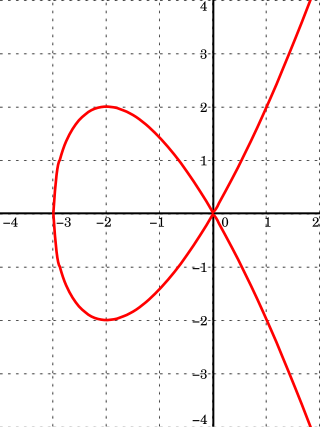In mathematics, complex geometry is the study of geometric structures and constructions arising out of, or described by, the complex numbers. In particular, complex geometry is concerned with the study of spaces such as complex manifolds and complex algebraic varieties, functions of several complex variables, and holomorphic constructions such as holomorphic vector bundles and coherent sheaves. Application of transcendental methods to algebraic geometry falls in this category, together with more geometric aspects of complex analysis.
The Riemann–Roch theorem is an important theorem in mathematics, specifically in complex analysis and algebraic geometry, for the computation of the dimension of the space of meromorphic functions with prescribed zeros and allowed poles. It relates the complex analysis of a connected compact Riemann surface with the surface's purely topological genus g, in a way that can be carried over into purely algebraic settings.

In mathematics, an affine algebraic plane curve is the zero set of a polynomial in two variables. A projective algebraic plane curve is the zero set in a projective plane of a homogeneous polynomial in three variables. An affine algebraic plane curve can be completed in a projective algebraic plane curve by homogenizing its defining polynomial. Conversely, a projective algebraic plane curve of homogeneous equation h(x, y, t) = 0 can be restricted to the affine algebraic plane curve of equation h(x, y, 1) = 0. These two operations are each inverse to the other; therefore, the phrase algebraic plane curve is often used without specifying explicitly whether it is the affine or the projective case that is considered.

In algebraic geometry, a projective variety over an algebraically closed field k is a subset of some projective n-space over k that is the zero-locus of some finite family of homogeneous polynomials of n + 1 variables with coefficients in k, that generate a prime ideal, the defining ideal of the variety. Equivalently, an algebraic variety is projective if it can be embedded as a Zariski closed subvariety of .
In mathematics, the canonical bundle of a non-singular algebraic variety of dimension over a field is the line bundle , which is the nth exterior power of the cotangent bundle on .

In algebraic geometry, a linear system of divisors is an algebraic generalization of the geometric notion of a family of curves; the dimension of the linear system corresponds to the number of parameters of the family.
In mathematics, a distinctive feature of algebraic geometry is that some line bundles on a projective variety can be considered "positive", while others are "negative". The most important notion of positivity is that of an ample line bundle, although there are several related classes of line bundles. Roughly speaking, positivity properties of a line bundle are related to having many global sections. Understanding the ample line bundles on a given variety X amounts to understanding the different ways of mapping X into projective space. In view of the correspondence between line bundles and divisors, there is an equivalent notion of an ample divisor.
In algebraic geometry, divisors are a generalization of codimension-1 subvarieties of algebraic varieties. Two different generalizations are in common use, Cartier divisors and Weil divisors. Both are derived from the notion of divisibility in the integers and algebraic number fields.
In algebraic geometry, the Kodaira dimensionκ(X) measures the size of the canonical model of a projective variety X.
In mathematics, the Hirzebruch–Riemann–Roch theorem, named after Friedrich Hirzebruch, Bernhard Riemann, and Gustav Roch, is Hirzebruch's 1954 result generalizing the classical Riemann–Roch theorem on Riemann surfaces to all complex algebraic varieties of higher dimensions. The result paved the way for the Grothendieck–Hirzebruch–Riemann–Roch theorem proved about three years later.
In mathematics, the Enriques–Kodaira classification groups compact complex surfaces into ten classes, each parametrized by a moduli space. For most of the classes the moduli spaces are well understood, but for the class of surfaces of general type the moduli spaces seem too complicated to describe explicitly, though some components are known.
In algebraic geometry, the geometric genus is a basic birational invariant pg of algebraic varieties and complex manifolds.
In mathematics, especially in algebraic geometry and the theory of complex manifolds, the adjunction formula relates the canonical bundle of a variety and a hypersurface inside that variety. It is often used to deduce facts about varieties embedded in well-behaved spaces such as projective space or to prove theorems by induction.
In algebraic geometry, the Iitaka dimension of a line bundle L on an algebraic variety X is the dimension of the image of the rational map to projective space determined by L. This is 1 less than the dimension of the section ring of L
In mathematics, the cone of curves of an algebraic variety is a combinatorial invariant of importance to the birational geometry of .
In mathematics, Arakelov theory is an approach to Diophantine geometry, named for Suren Arakelov. It is used to study Diophantine equations in higher dimensions.
In mathematics, especially in algebraic geometry and the theory of complex manifolds, coherent sheaf cohomology is a technique for producing functions with specified properties. Many geometric questions can be formulated as questions about the existence of sections of line bundles or of more general coherent sheaves; such sections can be viewed as generalized functions. Cohomology provides computable tools for producing sections, or explaining why they do not exist. It also provides invariants to distinguish one algebraic variety from another.
In algebraic geometry, a branch of mathematics, the Lefschetz theorem on (1,1)-classes, named after Solomon Lefschetz, is a classical statement relating holomorphic line bundles on a compact Kähler manifold to classes in its integral cohomology. It is the only case of the Hodge conjecture which has been proved for all Kähler manifolds.
This is a glossary of algebraic geometry.














